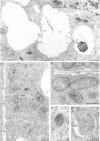The effect of pre-incubation of Allium cepa L. roots in the ATH-rich extract on Pb uptake and localization
- PMID: 22895797
- PMCID: PMC3604584
- DOI: 10.1007/s00709-012-0445-z
The effect of pre-incubation of Allium cepa L. roots in the ATH-rich extract on Pb uptake and localization
Abstract
The positive influence of anthocyanin (ATH) on toxic metal-treated plant material is well documented; however, it is still not explained if it is caused by changes in element absorption and distribution. Therefore, detailed analysis of the effect of the ATH-rich extract from red cabbage leaves on Pb uptake and localization at morphological, anatomical and ultrastructural level was the goal of this study. Two-day-old adventitious roots of Allium cepa L. (cv. Polanowska) were treated for 2 h with the aqueous solution of Pb(NO3)2 at the concentration of 100 μM with or without preliminary incubation in the anthocyanin-rich extract from Brassica oleracea L. var. capitata rubra leaves (250 μM, 3 h). The red cabbage extract did not change the total Pb uptake but it enhanced the translocation of accumulated metal from roots to shoots. Within the pretreated roots, more Pb was deposited in their basal part and definitely smaller amount of the metal was bound in the apoplast of the outer layers of cortex cells. The ultrastructural analysis (transmission electron microscopy and X-ray microanalysis) revealed that the ATH-rich extract lowered the number of Pb deposits in intracellular spaces, cell wall and cytoplasm of root meristematic cells as well as in such organelles important to cell metabolism as mitochondria, plastids and nucleus. The Pb deposits were preferably localised in those vacuoles where ATH also occurred. This sequestration of Pb in vacuoles is probably responsible for reduction of metal cytotoxicity and consequently could lead to better plant growth.
Figures







Similar articles
-
The effects of the anthocyanin-rich extract from red cabbage leaves on Allium cepa L. root tip cell ultrastructure.Ecotoxicol Environ Saf. 2011 Jan;74(1):93-8. doi: 10.1016/j.ecoenv.2010.06.018. Epub 2010 Jul 22. Ecotoxicol Environ Saf. 2011. PMID: 20650531
-
Effects of anthocyanin-rich extract from red cabbage leaves on meristematic cells of Allium cepa L. roots treated with heavy metals.Ecotoxicol Environ Saf. 2007 Nov;68(3):343-50. doi: 10.1016/j.ecoenv.2007.02.004. Epub 2007 Apr 9. Ecotoxicol Environ Saf. 2007. PMID: 17416417
-
Pb-induced cellular defense system in the root meristematic cells of Allium sativum L.BMC Plant Biol. 2010 Mar 2;10:40. doi: 10.1186/1471-2229-10-40. BMC Plant Biol. 2010. PMID: 20196842 Free PMC article.
-
Effects of lead on the morphology and structure of the nucleolus in the root tip meristematic cells of Allium cepa L.Int J Mol Sci. 2014 Jul 31;15(8):13406-23. doi: 10.3390/ijms150813406. Int J Mol Sci. 2014. PMID: 25089875 Free PMC article.
-
Subcellular localization of cadmium in the root cells of Allium cepa by electron energy loss spectroscopy and cytochemistry.J Biosci. 2004 Sep;29(3):329-35. doi: 10.1007/BF02702615. J Biosci. 2004. PMID: 15381854
Cited by
-
Lead-induced changes in plant cell ultrastructure: an overview.Biometals. 2025 Feb;38(1):1-19. doi: 10.1007/s10534-024-00639-5. Epub 2024 Sep 26. Biometals. 2025. PMID: 39325137 Review.
-
Synergetic modulation of plant cadmium tolerance via MYB75-mediated ROS homeostasis and transcriptional regulation.Plant Cell Rep. 2022 Jul;41(7):1515-1530. doi: 10.1007/s00299-022-02871-0. Epub 2022 May 3. Plant Cell Rep. 2022. PMID: 35503475
-
Protective role of jaboticaba Plinia peruviana peel extract in copper-induced cytotoxicity in Allium cepa.Environ Sci Pollut Res Int. 2018 Dec;25(35):35322-35329. doi: 10.1007/s11356-018-3420-1. Epub 2018 Oct 19. Environ Sci Pollut Res Int. 2018. PMID: 30341761
References
-
- Alkorta I, Hernández Allica J, Becerri JM, Amezaga I, Albizu I, Garbisu C. Recent findings on the phytoremediation of soils contaminated with environmentally toxic heavy metals and metalloids such as zinc, cadmium, lead, and arsen. Rev Environ Sci Bio/Tech. 2004;3:71–90. doi: 10.1023/B:RESB.0000040059.70899.3d. - DOI
-
- Baranowska-Morek A, Wierzbicka M. Localization of lead in root tip of Dianthus carthusianorum. Acta Biol Cracov Bot. 2004;46:45–56.
-
- Brännvall ML, Bindler R, Renberg I, Emteryd O, Bartnicki J, Billström K. The Medieval metal industry was the cradle of modern large-scale atmospheric lead pollution in northern Europe. Environ Sci Technol. 1999;33:4391–4395. doi: 10.1021/es990279n. - DOI
-
- Buchauer MJ. Contamination of soil and vegetation near a zinc smelter by zinc, cadmium, copper and lead. Environ Sci Technol. 1973;7:131–135. doi: 10.1021/es60074a004. - DOI
Publication types
MeSH terms
Substances
LinkOut - more resources
Full Text Sources

